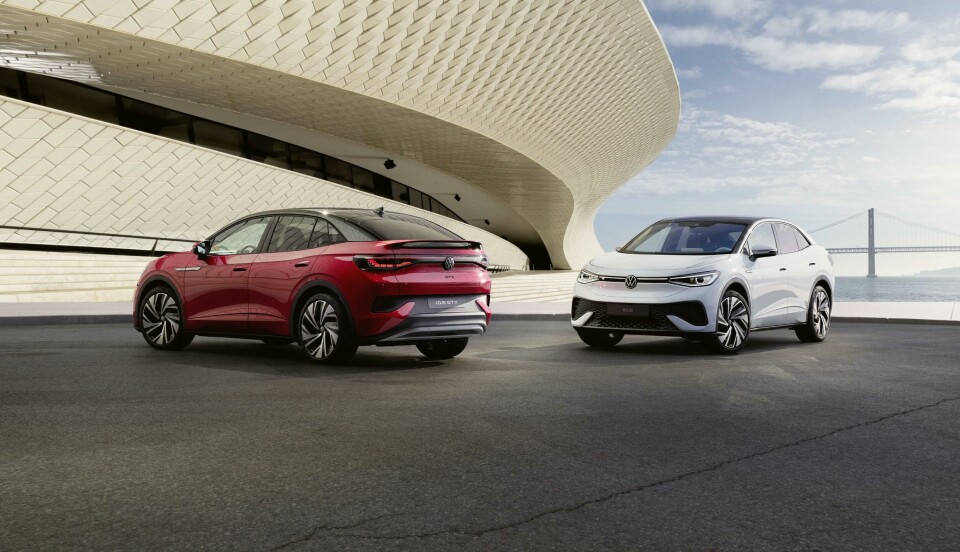
VW ID.5 and ID.5 GTX finally unveiled in production form
The third chapter in Volkwagen’s electric offensive is unfolding, and appears to have an air of familiarity
We’ve known about VW’s electric dreams for awhile, and the third chapter – after its ID.3 and ID.4 – became real this week as the ID.5 and ID.5 GTX were revealed to the world via livestream. Closely based on the VW I.D. CROZZ concept shown at the 2017 Shanghai motorshow and the VW I.D. CROZZ II unveiled later the same year at the Frankfurt Motorshow, the production compact SUV coupes were thus not a massive visual surprise, and are very similar to each other and indeed their ID.4 forebear.
The ID.5 measures up at 4599mm long compared to the GTX’s slightly shorter 4582mmm, both their widths (1852mm) and wheelbases (2766mm) are identical and the ID.5 is just a fraction lower at 1613mm (versus the sportier GTX’s 1619mm). That’s broadly similar to the ID.4 from which they share the same wheelbase and width too, the ID.4 being just a bit taller than both (1636mm). In the limited context of potential full-electric compact SUV rivals, the ID.5 sits between the shorter Volvo C40 Recharge (4431mm) and the much longer Tesla Model Y (4750mm).
Aerodynamic performance has been a focus in the design of the ID.5 and they achieve good-for-class 0.26 Cd (ID.5) and 0.27 Cd (ID.5 GTX) drag coefficient figures. This is partly enabled by the sloping roofline and smoothly tapering body towards the rear but also assisted by the ‘open’ rear-end spoiler, further underbody spoilers and even the flush door handles and flat-ish wheels.
Visual differentiation between the ID.5 and ID.5 GTX is minimal and mainly relates to the front lower air-intake area. The regular ID.5 has distinctive, inward and upward body-coloured ‘fangs’ while the GTX sports a simpler joined-up body-coloured section under the front bumper lip plus vertically-arranged triple LED lights at each edge. Another quick identifier between the two is the metal fillet at the end of the main side feature line: in the GTX it is about twice the length and helpfully has ‘GTX’ written on it to confirm as much.
The ID.5’s interior looks the same as the ID.4 in aesthetic layout up front, and VW says rear space is not compromised by the ID.5’s sloping roof. Without being able to sit inside to check, we can only take VW’s PR words at face value for now, which claim “a feeling of spaciousness and plenty of headroom, even for passengers in the second row of seats”. Its engineers have managed to make the ID.5’s 549-litre boot space slightly bigger than the ID.4’s, and rising to 1561 litres with seats folded down. No mean feat.
Upfront, the dash layout seems the same but the central 12-inch touchscreen benefits from what VW is calling ‘3.0 software’ which allows for over-the-air updates and upgrades. Tesla, Volvo and Polestar, have been offering such updates for some time though.
In terms of powertrain and performance the ID.5 offers three power options – 174bhp, 204bhp and 299bhp – and one 77kWh battery good for up to 323 miles of range in the ID.5 and 298 miles for the top-of-the-range all-wheel drive 299bhp ID.5 GTX (which can also hit 0-62mph in 6.3 seconds).
VW says the ID.5 will be handed over to customers with a ‘carbon-neutral balance sheet’. The company is aiming to cut carbon emissions by 30% by 2025, 40% by 2030, and be climate neutral by 2050 “at the latest”. Car Design News recently spoke to head designer Klaus Zyciora about these goals and the challenge of achieving “true sustainability”. From a business persecutive, this popular variant, within what is a massive sales segment, makes the ID.5 another important model in VW’s quest to be the global market leader for electric mobility by 2025. The turnaround continues.












